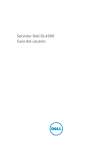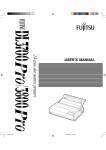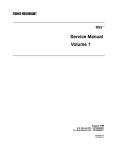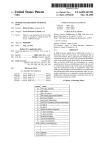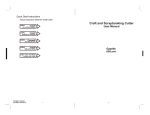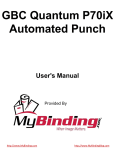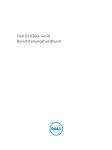Download Professional Laminating Systems II Series User`s guide
Transcript
XM4400 Adhesive Application & Laminating System User’s Guide P/N 3355 Revision: C 02/09/10 1 Table of Contents Introduction……………………………………………………………………………………… 3 Technical Specifications………………………………………………………………………. 3 Warnings………………………………………………………………………………………… 3 Contents of the XM4400 machine box……………….……………………………………… 4 Unpacking and assembling the cart…………………………………………………………. 4 Unpacking and positioning the machine……………………………………………………. 4 Cart Assembly – Exploded View / Parts Table……………………………………………… 5 Cart Assembly Instructions…………………………………………………………………… 6 Securing Machine to Cart……………………………………………………………………… 10 XM4400 control panel………………………………………………………………………….. 11 Film Pre-Cautions……………………………………………………………………………….. 12 Economizing with Film…….…………………………………………………………………… 12 Machine Rollers, Bars and Supply Roll Locations …….………………………………… 13 Web Path Diagram for Loading Laminate…………………………………………………… 13 Loading laminate film…………………………………………………………………………. 14 Troubleshooting tip for loading laminate………………………………….……………….. 16 Caring for your rollers…………………………………………………………………………. 16 Laminating items……………………………………………………..………………………… 17 Cutting Laminate…….…………………………………………………………………………. 18 Laminating Multiple items……………………………………………………..……………… 19 Machine troubleshooting…………………………………………………………………….. 20 Machine Exploded View……..……………………………………………………………….. 22 Maintenance Schedule………………….……………………………………………………. 22 Supply Rolls / Optional Equipment …………………………………………………………. 22 Machine Cleaning Points……….…………………………………………………………….. 23 Machine Cleaning Instructions………………………………………………………………. 23 Replacing Supply Rolls ………………………………………………………………………. 24 Technical Support ……………………………………………………………………….……. 25 Product Warranty / Cautions / Exclusions …………………………………………………… 25 Contact Xyron………………………………………………………………………..………….. 25 2 Introduction Thank you for purchasing the XyronPro XM4400 Adhesive Transfer and Laminating System. We are sure you will find this laminator to be useful, reliable, and easy-to-use. The XM4400 is designed to apply high quality, adhesive or bubble free laminate to posters, banners, and any other visuals up to 42 inches wide and up to 300 feet long that you want to protect for future use. The machine and supplies are compatible with all types of computer-printed media including laser, inkjet, color and thermal in a wide range of material sizes. Technical Specifications Mechanical Electrically Driven cold lamination 110V @ 2 Amp (max) Supplies See page 17 for detailed supply roll information Electrically driven cold lamination 110V @ 2 Amp (max) Document size (max) 42” (W) x 300 feet (L) [108 cm (W) x 91.4 m (L)] Laminate total thickness 0.004 inches (0.1 mm) Document thickness 0.0 to 0.10 inches (2.54 mm) Machine footprint [Inches] 50.5" L x 11" W x 14.5" H Machine footprint [cm] 128.3 cm (L) x 27.94 cm (W) x 36.83 cm (H)] Stand footprint [Inches] 49.5" L x 22" W x 28" H Stand footprint [cm] 125.7 cm (L) x 55.88 cm (W) x 71.12 cm (H) Machine weight 155 lbs. (70.45 kg) Warnings 1. Read and understand the Operation Manual and all safety labels before operating this machine. 2. Only a trained person is to be permitted to operate this machine. Training should include instruction in operation under normal conditions and emergency situations. 3. This machine is to be serviced only by trained and authorized personnel. Follow lockout procedures before servicing. 4. Never reach into the machine for any reason unless the machine is at a COMPLETE STOP. 5. Never leave the machine stopped in such a manner that another worker can start the machine while you are working on or within the machine. 6. Never change or defeat the function of electrical interlocks or other machine "shutdown" switches. 7. Before starting this machine, check that: - All persons are clear of the machine. - No maintenance work is being performed on the machine. - All guards are in place. - All laminate rolls are well secured in the side plate slots. - The machine is free of paper scraps, wraps and jams. 8. Equipment has pinch points that can cause injury. Keep hands, loose clothing, jewelry or hair away from rollers during loading of the film. 9. Cutter has an exposed blade that could cause personal injury if contact is made. Use caution when using or handling the hand held cutters. 10. Electric Shock Hazard. Do not open machine covers. No user serviceable parts inside covers. 11. The socket-outlet shall be installed near the equipment and shall be easily accessible. 3 Contents of the XM4400 The XM4400 is fully assembled and requires minimal set up other than unpacking the machine, assembly of the cart, mounting the machine to the cart, plugging it in, and loading the film. You will find the contents of the box to include: 1. XM4400 machine 2. In-Feed tray with paddle [3309] 3. Un-assembled cart components a. (2) Rectangle Cross Bar [3346] b. (2) Cart frame end pieces [3806] c. (4) 1/4"-20" x 2.25" hex head bolts [3330] d. (4) 1/4" washers [2143-02] e. (4) 1/4" split washers [2189-04] f. (4) 5/16"-18 Nylock nut – Black [3803] g. (4) 5/16" Washer – Black [3804] h. (2) 4” Swivel Caster [3808] i. (2) 4” Swivel Caster W/ Brake [3809] j. (4) Caster Mounting Bolt, 5/16-18 X 2.75" [3807] k. (4) Caster Shoulder Bolt, 2.225" X .371" [3812] l. (4) Lock Nut Nylon, .371" [3814] m. 4. Tools included a. (1) 3/16” Hex wrench for assembly [3352] b. (1) 1/8” Hex wrench for sprocket / chain adjustment [3354] 5. Warranty card [XLT-PRO-01] 6. (2) Hand held cutters [3351] 7. XM4400 User's Guide [3355] Unpacking and Assembly of the Cart It is necessary to have two people unpack and assemble the cart and laminator. Unpack the contents, lay them out on a table or floor and check vs. the contents list above. If you are missing any items, please contact customer service [See contact information in the back of this manual]. . 4 XM4400 Cart Assembly Exploded view of Cart Assembly: Shows Cross bar assembly and hardware 5 Cart Assembly Instructions 1. The cart assembly is begun by assembly of the right side assembly frame end to the 2 cross bars [3346] with a 2 ¼” Hex Head bolt [3330] with washer [2143-02] and split lock washer [2189-04]. Install the upper cross bar by Inserting the metal dowel pin into the pilot hole and then inserting and locating the threaded bolt into the screw hole. Tighten the bolt using the 3/16” Hex wrench for assembly [3352] and then assemble the bottom cross bar. See figure 1 / 2. Then fit and assemble the cross bars to the left side frame end in by inserting the metal dowel pin into the pilot holes of both the upper and lower cross bars and tightening until secured. Figure 1: Cross bars assembled one side at a time Figure 2: Bolt with washer and lock washer 2. Once the cart frame has been assembled, turn the frame upside down in order to mount the caster frames and caster wheels. 3. The caster components [mounting frame, wheel and hardware are packaged together. See figure 3. Figure 3: Caster components and hardware 6 4. To assemble the caster wheel frame, begin by mounting the caster frames to the cart frame ends by threading the cart threaded stem into bottom weld nut of the cart frame ends. See figure 4 / 5. Figure 4/5: Using hardware supplied, secure caster frame to cart 5. Thread the caster bolt stem up through the weld nut on the bottom side and through hole on the top side of the new cart frame ends. Secure using a Black Washer and Black Nylock nut. The threaded stem must be flat or flush on the top of the nylock nut. Do not over tighten the Nylock nut as this will deform the cart frame. See figure 6 Figure 6: Nylock nut thread position – flush / flat at top of nut - Critical DO NOT OVER TIGHTEN THE NYLOCK NUT!! OVER TIGHTENING CAN RESULT IN DEFORMATION OF THE CART FRAME. 7 6. Next assemble the casters by inserting the wheel into the caster frames and secure with the caster bold and nut which were provided with the casters. See figure 7 / 8 Figure 7 / 8: Caster wheel assembled 7. Next assemble the casters by inserting the wheel into the caster frames and secure with the caster bold and nut which were provided with the casters. See figure 9 / 10 Figure 9: Non-Brake caster mounted Figure 10: Brake caster mounted Note: Left side of stand has locking caster in front and non-locking caster in back. 8. Once assembly is completed, insert the end caps [3331] into the cart frame. 8 Assembled Machine Cart Unpacking and Positioning the Machine To begin unpacking, remove the packing from around the machine. CAUTION: The machine weighs 155 Lbs [70.45 Kg], have someone assist you in lifting the machine onto the mobile stand. Please lift from under the ends of the machine. DO NOT LIFT USING ANY OF THE ROLLERS. Remember when lifting to bend your knees and keep your back straight to prevent over stressing and possible injury to your back. Remove the packaging from around the machine. Position the machine ends over the top bars on the cart. On the underside of each end of the machine there are two threaded holes. These holes need to align over the holes in the top bars of the cart. Install the four bolts up through the holes in the bars and into the threaded holes. Turn the bolts in as far as possible by hand. Then tighten all four bolts with the supplied Allen wrench. 9 Securing Machine to Cart The machine should be placed so that you have full access to all four sides of the machine. Ensure that the power and foot pedal cables are not in a hazardous position on the floor. Check the area to the rear of the machine where laminated items will exit. A flat surface is desired for items to exit onto. Be sure to clean the area so items do not gather dust. Positioning and securing the machine on the cart Machine Mounting Instructions 1. Set machine onto Cart Frame Assembly over screw holes 2. Secure machine to cart using (4) 2 ¼” Hex Head bolt [1].], split washers [X] and flat washers [X] as shown above. 10 XM4400 Control Panel Control panel – Top View Control panel - Front View The control panel for the XM4400 is located on the right hand side of the machine. The following paragraphs review each of the controls. Auto / Foot The Auto/Foot Switch changes the motor control modes. Auto mode allows the motor to run constantly. Foot mode allows you to start and stop the machine by pressing and releasing the foot pedal, allowing for greater control. Foot mode is the default. Forward / Reverse The Forward/Reverse Switch changes the motor direction. During normal operation the machine should always be switched to "forward" mode. The main reason for using the "reverse" setting would be to remove an installed roll of material. Emergency Stop Button The Emergency Stop Button will immediately stop the machine if pressed. To release the emergency stop, twist it clockwise. The emergency stop button will override all other switches including the ON/OFF switch. Power Button The Power Button is the main power switch. The XM4400 can only be operated when the button has been depressed and the indicator lamp is lit. To turn machine off, depress the power button again and the indicator light will turn off. 11 Film Pre-Cautions Below are several precautions which must be followed when handling film: 1. Adhesive side of the film must be oriented away (on the outside) from the laminating roll. Otherwise it will immediately bond to the roll, creating a major clean-up project. 2. Films have a shiny side and a dull side. The dull side is the one with the adhesive. The dull side should ALWAYS face outward from the laminating roll. 3. Always mount the film so that the adhesive side faces outward from the laminating roll. This will prevent hours of roll cleaning. 4. If the two films are not aligned, feed problems, wrinkles and other assorted troubles will occur. 5. Carefully align the two films being fed into the nip. If not, you will obtain poor results. Economizing with film There are many ways to economize with the film. Following are four of the most common. (1) Minimize the gap between items being laminated (not always possible). You may even overlap the beginning and end o following items if there is an area on the items which will be removed after lamination. (2) Use a film which is the same width as the items being laminated (this does require accurate item feeding). (3) At the beginning of a run, lay the first item over the load plate so that as the plate s fed into the machine the item laying on top of it is coated. This can leave a faint mark in the item which may fade with time. 12 Machine Rollers, Idler Bars and Supply Roll Locations Web Path Diagram for Loading Laminate Laminate Roll Mask Roll Laminate Path Adhesive Path Laminate Roll 13 Adhesive Roll Loading Film Each roll of material comes with an extra 5 feet of material that allows for proper loading without wasting the purchased material. Before starting the loading process, remove tray from the machine. Step 1: • • • Match the colored dots on the end of each supply roll with the corresponding dots on the side of the machine. Note which roll is identified as "top" and "bottom." The "bottom" roll has a starter section. Slide the supply rolls into the grooves in the sides of the machine; making certain that the roll is inserted completely. Insert the Top and Bottom roll as shown Step 2: • • • • • • On the bottom supply roll, grasp the starter section by the leading edge. Route over the bottom idler bar adjacent to the lower rubber roller. Make sure the starter film is inserted squarely between the two rubber rollers. Use the foot pedal to run the starter section into rubber rollers. Ensure that the film is exiting under the cutter bar assembly. (If not, refer to the "troubleshooting tips" immediately following the load directions). Run approximately half of the starter section into rollers. Be sure not to advance any film with adhesive exposed into the rollers! Start the bottom leader between the rubber rollers using the foot pedal WARNING! Equipment has pinch points that can cause injury. Keep hands, loose clothing, jewelry or hair away from rollers during loading of the film. 14 Loading Film (Continued) Step 3: • • Make certain the lower film is tight. If necessary, rotate the supply roll backwards to tighten. Grasp the film from the upper supply roll, and adhere it to the exposed adhesive on the lower supply roll. For best results, adhere the top film 1 inch below the round steel idler bar. By carefully aligning the edges, keeping the film tight and avoiding wrinkles, film waste will be minimized. Step 4: • • • • • • Use the foot pedal to run the film through the machine. Ensure that the film is exiting under the cutter bar assembly. Run material through the machine until all wrinkles go away. Material amount will vary depending on loading accuracy. Expect to run approximately 3 to 4 feet through the system. Trim off excess film by using the hand held cutter and sliding it in either direction. Step 5: • Tacking laminate from top roll to exposed adhesive on bottom roll Guide film out the back of the machine Install feed tray completely by aligning the support posts in the grooves located in the sides of the machine. First, insert right side of tray Second, insert the left side of tray You are now ready to feed your documents! 15 Troubleshooting Tips for Loading Film If material wraps around the top pinch roller: 1. Remove the bar located on the output side of the pinch rollers by lifting it out of the way. 3. Be careful not to damage the rubber rollers, feed some more material through the system. 4. Run enough material through the system to eliminate all wrinkles. 5. Remove the excess material. Caring for your rollers The XM4400 System rollers are of high quality and durability, however, to prevent non-warranty damage, please observe the following precautions. 1. Clean only when needed, with recommended cleaning solution. Isopropyl alcohol rubbed lightly on the rollers is good cleaning solution. Roller cleaning fluids are available commercially. 2. Be careful with knives or other sharp objects near the rollers. Cutting or puncturing a roller will cause repeating marks in the rollers and is not covered under the machine warranty and may cause imprint patterns into future laminated items. 3. Do not allow anything over 1 /16" thick objects to pass through the rollers. A large irregular object passing through the rollers may cause damage to the rollers. 16 Feeding Items into Machine The initial feeding of an item into the machine is the most important part of the process. If an item enters the machine on an angle, or with wrinkles in the leading edge, the output may end up with wrinkles. Some items are easier than others. Generally smaller and more rigid items are the easiest. A very large, thin item is more challenging, but should provide few problems if fed into the machine correctly. With a little practice it is easy to feed items into the machine properly 100% of the time. Single items This is the most common use, in which single items are fed into the machine one after the other. This example covers most of the techniques involved in proper use of the machine. 1. Switch the machine to "Foot" mode. Do not start the rollers turning yet. 2. Pull the paddle back to stop. This will raise paddle leaving clearance under paddle to insert media into machine. Paddle will raise approximately 1/8”. Ensuring the leading edge of your document is flat is very important, as a small wrinkle at this point may continue through an entire document. Lay the item flat on the feed tray and slightly stretch the leading edge with your fingers to make it lay flat. Move the item under the paddle and onto the rollers until it is touching the film. Press the paddle forward and down to force contact between the media and adhesive. Pull back he paddle Load item under the paddle, squarely to film 3. Once you are satisfied that the item is straight and flat, Press the foot pedal. As the document begins feeding through the system, lower the paddle by sliding it forward. Use control buttons on housing or if foot pedal to advance once the media is feeding. Do not push the item into the machine, as this will wrinkle the leading edge; instead, allow the rollers to grip and pull in the item. Once the item has passed through the rollers, you may stop the machine and prepare the next item in the same method as above. If you are only laminating one item and need it removed from the machine, keep the motor running until it has passed through the rollers. Push paddle forward 17 Cutting Material To cut the material off after your document(s) have passed through the machine, please follow the instructions below: 1. Place the document over the edge of the output side of the machine housing. 2. Using the handheld cutter [3351], place the cutter onto the edge of the material at the point you wish to cut off the excess. 3. Pull material tight to apply tension to film when cutting 4. To cut the material, pull the blade along the edge of the machine to cut the material. 5. Apply force down the length of the material to full cut and separate the material from the supply roll. 6. Additional trimming of any excess laminate can now be done to your document. Note: Cutting can be performed from either side of machine. Icon is provided to indicate the recommended cutting area and direction. Cutting direction on back of machine Apply tension to film when cutting 18 Feeding multiple items You can feed as many small items into the machine next to one another as you are capable of handling, however, all items for side-by-side laminating must be the same thickness. If you are feeding items with a combined width narrower than that of the film and of the same thickness, you can feed them side-by-side to prevent wasting material. Following the instructions for feeding single items to ensure straightness, feed the items into the machine next to each other with a gap in between them in case your item is not straight. This will prevent the items from overlapping. It is very important to ensure that the items are straight as multiple items may overlap on one another if improperly fed into the machine. For this process, you may wish to have an assistant. Note: Poor quality of lamination in between the items is due to the roller being lifted slightly; however, after trimming this effect is not noticeable. The thicker the items you laminate, the more you will notice this. Allow space between items when laminating multiple items 19 Machine Troubleshooting SYMPTOM Long documents are not aligned with film layers after laminating. POSSIBLE PROBLEM Feed tray not installed correctly. Documents tend to wrinkle during lamination. Verify tray is completely installed. Verify supply rolls are completely seated at base of grooves in side plate. Clean adhesive buildup from blade using isopropyl alcohol. Replace blade if necessary. Handheld Cutter does not cut well. Film does not exit machine under pivoting cutter assembly. TEST/ACTION Film is curling. There is adhesive on the rubber roller. Paddle not operated correctly. Tray or paddle not flat. Remove stripper bar & reposition lower material roll Replace stripper bar. Clean adhesive from nip rollers. Ensure paddle is pushed forward completely after document is loaded, aligned, and has begun lamination. Do not press down on tray during feeding of documents. Check for adhesive build-up and clean machine if present. Document difficult to load Film wrinkles don't go away as material is run through the machine. Paddle not pulled back in load position. Check paddle and tray for flatness and wear. Prior to loading document, pull paddle back to "load" position. Adhesive build-up on underside of paddle or leading edge of tray. Ensure underside of paddle is clear of any obstruction or adhesive buildup. Check to see if the upper and/or lower supply roll(s) are firmly seated in grooves within side plate(s). Verify supply rolls are firmly seated at base of grooves in side plates. Shipping damage may cause a misalignment of film. 20 Verify Shipping damage has not occurred. Machine Troubleshooting (Continued) SYMPTOM Film does not lay flat, curls and / or wrinkles. The machine will not run. POSSIBLE PROBLEM Initial loading of film without advancement through machine until advancement could cause adhesive buildup on lower idler bar. Tension on film may cause wrinkles and is not a film quality issue. Loss of power or mechanical stop has been released. TEST/ACTION Clean adhesive buildup from idler roller using isopropyl alcohol. Check end hub tension and make sure the material is stress free. The power plug is pressed completely into its socket and there is power to the socket. The "Power" button is on. The green light should be on. The emergency stop has been released. The control mode (foot/auto) is correct. Static Sparks It is not uncommon for a small static spark to jump between two metal parts while the machine is running. This is static electricity, caused by friction between the plastic film and the machine, and is not a cause for concern. This phenomenon can be seen more often in dry and warm climates. If this is occurring you may also on rare occasions receive a tiny shock, the same as touching metal after walking over some carpets. 21 The fuse located in the rear of the machine is not blown. This effect will be fairly minor. If you feel something is wrong with the machine electrically, please cease using the machine and contact Xyron at 1 800 793-3523. XM4400 MACHINE EXPLODED VIEW MAINTENANCE SCHEDULE Monthly • • • • • Every Six Months • • Daily Clean the rolls Inspect the electrical cord for damage Inspect the optional footswitch for damage Check the chain tension Inspect the area around the laminator for possible hazards [i.e. dust buildup, combustible items, objects on floor, etc…] Lubricate the grease fittings and chain Check wire termination tightness SUPPLY ROLLS FOR XM4400 Product No. Description AT4301-300 Permanent High-Tack Adhesive AT4306-170 Repositionable Adhesive DL3800-300 2 Sided Standard Use Laminate DL4300-300 2 Sided Standard Use Laminate LAT3801-300 1 Side Standard Use Laminate/1 Side High-Tack Adhesive 22 Specifications 300 ft (91.4m) X 42 In (106.6cm) 170 ft (91.4m) X 42 In (106.6cm) 300 ft (91.4m) X 38 In (96.5cm) 300 ft (91.4m) X 42 In (106.6cm) 300 ft (91.4m) X 38 In (96.5cm) MACHINE CLEANING POINTS CLEANING INSTRUCTIONS 1. Clean only when needed, with recommended cleaning solution. Isopropyl alcohol is recommended. 2. Be careful with knives near the rollers. Cutting a roller will cause repeating marks in the rollers, and is non warranty damage. 3. Do not allow very thick objects to pass through the rollers. A large irregular object passing through the rollers may cause damage. Use the minimum amount of pressure necessary to clean the rolls. You can destroy the silicone layer on the rolls by pressing to hard or scrubbing too long in one spot. 4. Exercise care when cleaning the rolls with 80% isopropyl alcohol: A. Use only in a well ventilated area. B. Wear rubber gloves. 5. Harsh chemicals like toluene, acetone or MEK destroy the rollers and paint finish. 8. Do not use liquid or aerosol cleaners on the laminator. Do not spill liquid of any kind on the laminator as you can be severely shocked, electrocuted or cause a fire. Use only a damp cloth for cleaning. 23 REPLACING SUPPLY ROLLS 1 - Insert New Rolls Before starting this process make sure the power switch is in the off position, the auto/foot switch is set to foot and the directional switch set to forward. Locate the colored dots on the supply roll ends. Each roll will be designated as top or bottom. Matching colored dots, place rolls into machine. The bottom roll will have a laminated starter ready for use. [Starter is the leading edge of film which does not have exposed adhesive on top or bottom] 2 - Thread Material Place starter [leading edge of film] on rubber rollers following the routing path [shown to the right] and feed about 4” (100mm) through machine by pressing the Auto switch, make sure the forward switch is selected, next press the power button to advance material and press the power button once more to stop. If using a foot pedal, select the foot switch and then pressing the foot pedal to advance the material about 4” (100mm) through machine. To stop the feed of material Lift your foot off of the foot pedal. Next, pull about 8” (200mm) from the top roll down and align with bottom roll start while pulling down. Spread the film by pulling the material taught and press top roll film (leading edge) onto lower roll (leading edge). Run hand across the top film to adhere to the bottom rolls adhesive. Take care to keep film flat and stretched tight when adhering to the bottom roll. This will reduce film waste and wrinkling when advancing film through the machine. Ensure material exits the machine properly out the rear of the machine. Once material is flat & wrinkle free, trim excess film so you will be ready to run your documents through. 3 - Remove Rolls Remove feed tray by lifting up about 1" (25mm) and pulling out gently. Carefully cut film from top roll using the upper idler bar as a blade guide taking great care not to cut the rubber roller. Slide top roll out of machine. Put machine in reverse and remove film from bottom roller. 24 CONTACTING TECHNICAL SUPPORT For machine parts and technical service in North America, please call: 1-800-793-3523. Please provide serial number when calling for service. In Europe, please call: +49 711 8103 0. PRODUCT WARRANTY Xyron, Inc. warrants that the Xyron XM4400 is free from defects in material and workmanship for a period of one (1) year from the date of purchase. Xyron, Inc. will repair or replace a defective product or part without charge provided it is returned to the address below, freight prepaid with proof of purchase. If the product is damaged by neglect or misuse the warranty is null and void. WARRANTY CAUTION The warranty made herein is in lieu of all other warranties, express or implied, including any warranty or merchantability or fitness for a particular purpose. Xyron will not be liable for property damage or personal injury (unless primarily caused by its negligence), loss of profit or other incidental or consequential damages arising out of the use or inability to use the equipment. EXCLUSIONS TO THE WARRANTY This warranty specifically does not cover: 1. Damage to the laminating rolls caused by knives, razor blades, other sharp objects, or failure caused by adhesives. 2. Damage to the machine caused by lifting, tilting, and/or any attempt to position the machine other than rolling on the installed casters on even surfaces. 3. Improper use of the machine. NOTICE The information in this manual is subject to change without notice. Xyron shall not be liable for errors contained herein or for incidental or consequential damages in connection with the furnishing, performance or use of this material. The purchase or acquisition of this product does not confer the right or license to use the machine and cartridges in the retro-reflective field or to make or sell machines or cartridges for use in the retro-reflective field. XYRON, INC. , 8465 N. 90th St., Suite #6, Scottsdale, AZ 85258 Esselte Leitz GmbH & Co KG, Siemensstr. 64, 70469 Stuttgart, Germany 25


























